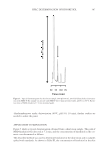PHYSICOCHEMICAL PROPERTIES OF DELIPIDIZED HAIR 365 on hair shaped into omega loops. Although there were no discernible differences between untreated virgin and untreated delipidized hair, in terms of stiffness and elasticity, we found that treatment with hair styling agents produced different effects depending on the hair type used. Using streaming potential measurements, we compared the affi nity of polyquaternium-55 and quaternium-26 to virgin and delipidized hair and found that their binding capacity depends on the lipid composition of hair. Figures 5 and 6 contain plots of streaming po- tential as a function of treatment time for virgin and delipidized hair treated with a cat- ionic surfactant (quaternium-26) and polymer (polyquaternium-55). As shown in Fig. 6, initial readings (only in KCl solution) for the streaming potential plot were normalized. In fact, under normal circumstances untreated hair has a negative charge resulting in negative streaming potential values. In any event, our decision to normalize the data was based on our desire to monitor any differences between the two hair types. Figure 6 shows the changes experienced by a plug of hair during a treatment cycle with quaternium-26. After treatment (2000 s), the streaming potential spikes followed by a decay correspond- ing to the rinse cycle (with KCl solution). After extended rinsing, a steady state is eventu- ally reached where the streaming potential values level off. The difference between surfactant- and polymer-treated hair is striking. As illustrated in Fig. 6, the degree of decay in the streaming potential for hair treated with a cationic polymer is much less than is the case with a cationic surfactant. Such a phenomenon can be explained by the greater affi nity of cationic polymers to hair (multiple-binding sites), which cannot be easily re- moved, especially with water rinsing. It is interesting to note that the cationic surfactant and polymer have less affi nity for delipidized hair. It is likely that binding of these com- pounds to the hair surface greatly relies on van der Waals stabilization, which would be facilitated by the presence of lipids. Hence, removal of lipids renders a surface free of other molecules which the cationic polymer and surfactant can associate with. Various mechanical properties of hair fi ber assemblies were measured using previously developed methodology in which hair is shaped into an omega loop and examined in its Figure 5. Streaming potential plot of virgin and delipidized hair treated with cationic surfactant (Quaternium-26).
JOURNAL OF COSMETIC SCIENCE 366 untreated and treated states (7). Several parameters are monitored and include stiffness, elasticity, fl exibility, and plasticity. Typically, this technique can be used to discern structure- function properties of materials. We also fi nd that many of the measured properties are de- pendent on molecular weight. For example, high molecular weight species normally yield higher stiffness ratios and fl exibility as opposed to their more brittle lower molecular weight counterparts. Figure 7 contains a plot of stiffness ratio for various grades of PVP with the following Mw values: PVP K-15 (Mw = 8,000), PVP K-30 (Mw = 60,000), PVP K-60 (Mw = 400,000), PVP K-90 (Mw = 1,300,000), and PVP K-120 (Mw = 3,000,000). As expected, stiffness of the omega loop polymer–fi ber assembly increases with increasing molecular weight of the polymer. When comparing virgin and delipidized hair, we found that there was no difference in any of the measured parameters in the untreated state. However, treat- ment with the ensemble of PVP samples clearly illustrated a directional trend in the stiff- ness ratio measurements. When a polymeric resin (in this case, PVP) was applied to delipidized hair, the polymer–hair fi ber assembly was stronger (higher stiffness) than virgin hair treated by the same regimen—an effect most likely determined by surface wetting characteristics of the chosen hair type, which would be governed by its lipid composition. WATER MANAGEMENT PROPERTIES OF HAIR We generated adsorption/desorption isotherms using DVS analysis to investigate if the water management properties of hair are greatly infl uenced by the presence, or absence, of lipids. This gravimetric technique monitors the solvent uptake by a material, in this case hair and water. DVS water sorption isotherms were generated by exposing hair to stepwise changes in RH—sorption for increasing humidity and desorption for decreasing humidity—starting from 0% to 90% RH and then from 90% to 0% RH. Overall, we found much greater uptake (sorption) in delipidized hair as compared to the virgin hair sample (Fig. 8). Examination of the hysteresis between sorption and desorption curves Figure 6. Streaming potential plot of virgin and delipidized hair treated with a cationic polymer (Polyquaternium-55).
Purchased for the exclusive use of nofirst nolast (unknown) From: SCC Media Library & Resource Center (library.scconline.org)





















































































